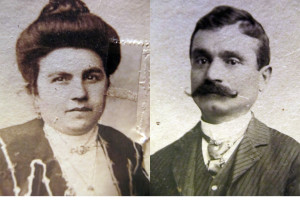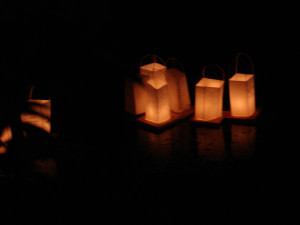If Bartlemy’s Day be fair and clear,
hope for a prosperous autumn this year.
So the saying goes. And so today is St. Bartholomew’s Day, St. Bart being one of the lesser known saints, but a very important one, nonetheless, for bookish types, especially those of us who make books: papermakers, printers, bookbinders, book artists in general. For the printers, St. Bart’s Day brings the celebratory Printers’ Wayzgoose, an English tradition, marking the day each late summer when printers typically returned candles and lamps to the shop for type setting. Daylight is waning, after all: it’s been in steady decline since the Midsummer solstice of June 21. We’ve been losing a few minutes of sunlight each day since then, and by now, just a few short weeks from the autumnal equinox, things are much different than they were at summer’s height in June. We are well on our way toward the dark time of the year.
As for the man himself, St. Bartholomew was one of the Twelve Apostles. Not much else is known about him. He may have traveled to India, to the area around Bombay. Tradition says that he met his end in Armenia in the First Century, and it was a gruesome death, in which he was flayed alive and then crucified upside down. The flaying, naturally, has made St. Bart a patron saint of butchers and tanners. The tanners are our first connection to book artists (think of the leather that fine binders use to bind books). As for butchers, well, we all have to eat. Many of my dad’s uncles and great uncles were butchers in Italy and in this country, and chances are they knew a thing or two about St. Bartholomew and his feast day. An old tradition in England was to make a Bartlemas Beef for the day’s meal, in which brisket was seasoned with wine and spices like ginger, nutmeg, cinnamon, cloves, and mace, then baked and served cold with mustard and sugar. It would take about three days to prepare, though (much like preparing a corned beef from scratch), so… my apologies, it’s much too late to plan on this for your table tonight. There’s always next year, however.
While the bookbinders were honoring St. Bartholomew with their leather bindings, the papermakers traditionally marked St. Bart’s Day in an “out with the old, in with the new” fashion, using up the last of their summer pulp in the vats by making paper not for the print shops but rather for folks to use to seal off their windows for the coming winter. Glass windows came into vogue much later; it was waxed paper that was used to keep out the elements back then. Once this St. Bart’s window paper was made, the papermakers went back to making paper for the printers, clearing out the vats and recharging them with new pulp made from rags that had been retting all summer.
Then there are the printers: They really took the day to heart, making St. Bartholomew’s Day the big printers’ holiday in England. A celebration was typically organized by the proprietor of the shop, marking this day traditionally associated with the shortening of the days and the need for candles and lanterns once more in the shop. The printers might get the day off and would receive a little extra pay, as well, which was typically spent on a goose to roast for the table (hence the name of the day, perhaps: “Wayzgoose”). Good food going hand in hand with good drink, the St. Bart’s Wayzgoose was also a day for plenty of ale and, in some places, mead, the delightful intoxicating beverage made from honey. Especially in Cornwall, where a Blessing of the Mead ceremony takes place even today. Continuing the road of connexions, our friend Bart is also a patron saint of beekeepers, and it was traditional in England to bring in the honey crop on August 24.
The Jerusalem Post, August 27, 2010, reported that Johannes Gutenberg’s 42-Line Bible, the first book printed from moveable type, was completed on St. Bartholomew’s Day in 1454. I tried finding other sources to back up this claim, but had no luck. Still, I like the idea of this and if it is indeed true, this may have something to do with the day becoming a matter of such importance to printers and bookbinders. No matter what is fact and what is legend, our view on the day is simple: It’s a day for celebrating the core traditions of the book arts: papermaking, printing, and bookbinding. If you are involved in these noble arts, as we are here at Convivio Bookworks, we hope you’ll mark the day by making something suitably bookish. And if you are not a maker but a book arts enthusiast, your job today is to appreciate a good book. And no matter what your role, certainly, you can celebrate a day with at least a few delightful names: Happy Wayzgoose. Happy Bartlemas.
Image: WAYZGOOSE set in historic wood type from our collection. Nearby, the first line gauge I ever bought. I got it at the supply store at the Penland School of Crafts, July 1994. I also met some of my very best friends there and then.


